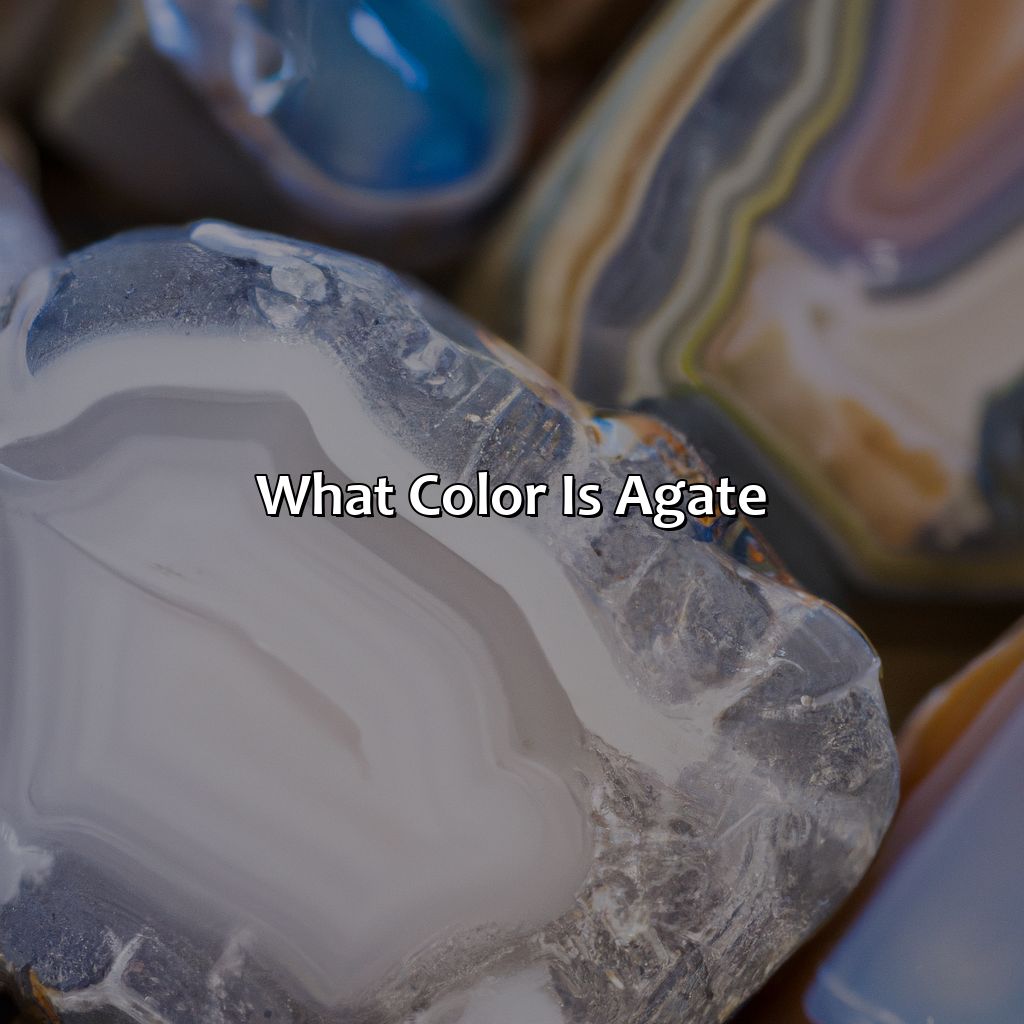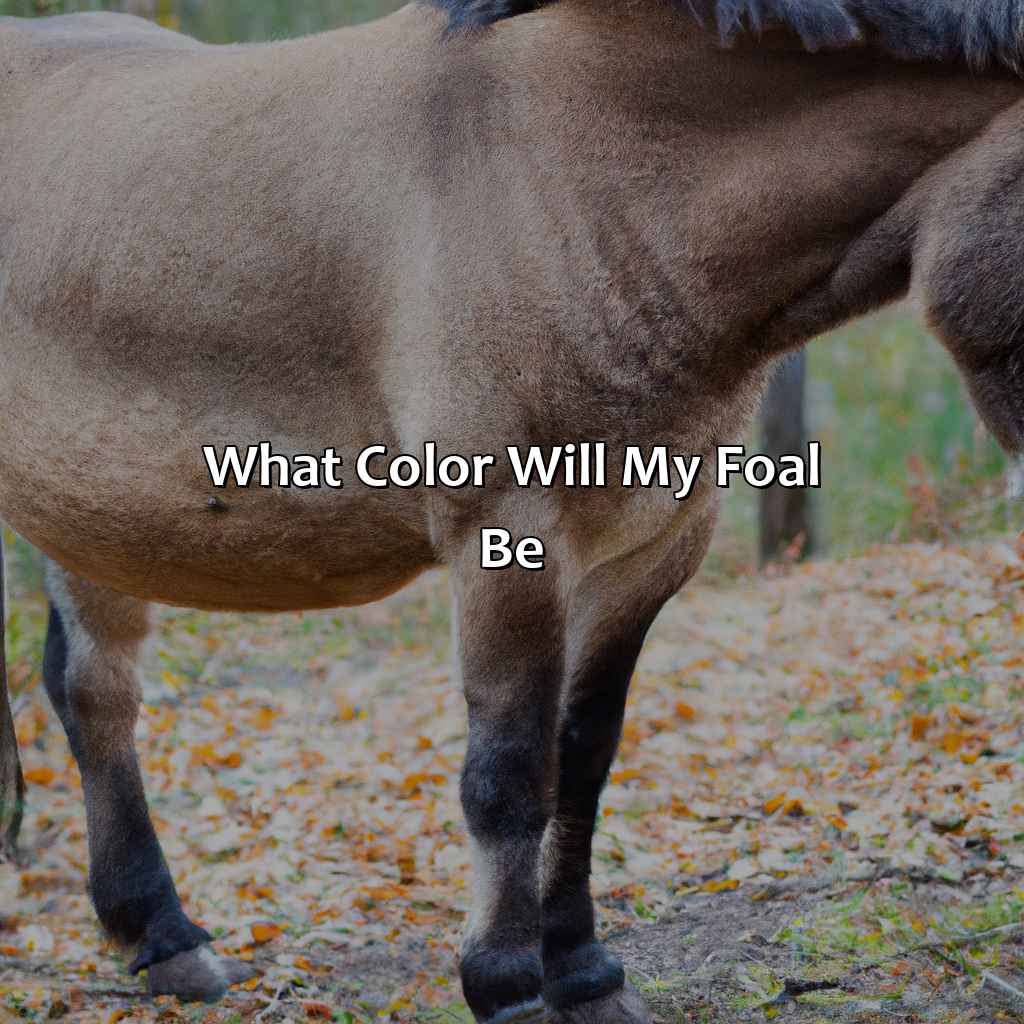Key Takeaway:
- Caramel color is a widely used food coloring that is added to a variety of food and beverage products to enhance their appearance and taste.
- Caramel color is produced through a process called the Maillard reaction, which involves heating sugar and other carbohydrate-rich materials to produce a brown color.
- Caramel color is classified into four types based on color intensity and hue, and is often used in baked goods, beverages, and dairy products due to its color stability and long shelf life.
Key Takeaway:
- Caramel color is considered safe by the FDA, but there are concerns about its potential toxicity and carcinogenic properties.
- Regulations on caramel color production aim to ensure food safety and minimize health risks associated with its consumption, such as allergies and product differentiation.
- Natural and synthetic alternatives to caramel color exist, including organic caramel color, but these alternatives may be more expensive and less color-stable than caramel color.
Key Takeaway:
- Caramel color is a common food additive that has a long history in culinary arts and candy making.
- Caramel color is produced from a variety of raw materials and under specific manufacturing conditions to achieve the desired color intensity and hue.
- Caramel color has various uses in the food and beverage industry, as well as in other industries like animal feed, cosmetics, and textiles due to its important properties like color stability and shelf life.
What is Caramel Color?

Photo Credits: colorscombo.com by Ethan Brown
To get a proper understanding of caramel color, we need to go deeper. Start with the definition, history, and chemistry. We find that caramel color is a major colorant additive. Its history goes back to culinary and candy making. There are different kinds of caramel color, classified by intensity and hue. Let’s look closer at each section to gain an overall knowledge of caramel color.
Definition of Caramel Color
Caramel color is a widely used colorant and additive in the food industry. It is produced by heat treatment of carbohydrates, resulting in a dark brown liquid or powdered substance. Used since the 1800s, caramel color adds depth and richness to various foods and beverages. There are four main types of caramel color: Class I, II, III, and IV. The type varies based on the intensity of the color and the source material used in production.
To produce caramel color, various methods can be used such as heating sugar or corn syrup under specific conditions until it reaches the desired color. Raw materials primarily used include sugars derived from sources such as corn, malt or cane sugar; starches such as potato or rice; and even sometimes molasses or lactose.
Regulations on caramel color production vary depending on country-specific regulations. In the US, there are strict FDA guidelines that must be followed regarding caramel coloring production.
Caramel color is mainly used in the food and beverage industry for its ability to impart an appealing brown hue to products such as cola drinks, beer, baked goods like breads and cakes, sauces, meat products like gravy and premium pet foods.
While USFDA has approved this product safe for consumption there are associated health risks to note upon high consumption however studies to prove toxicity specifically linked with Caramel Color remains unclear and there have been no conclusive evidence supporting any associations thus far.
Natural alternatives for Caramel Color exist which include vegetable juices, spices like turmeric if one wishes an organic label product whilst synthetic ones exist from other chemical dyes which produce similar end results without using glycated compounds.
One true fact about caramel coloring is that it was once commonly made using ammonia gas during processing until research demonstrated potential health risks,prompting industry shift towards safer alternatives. (Source: https://www.ncbi.nlm.nih.gov/pmc/articles/PMC5115628/) Culinary arts have been using caramel color since ancient times, making it the OG of candy making.
History of Caramel Color
Caramel Color’s Evolution through the Ages
Caramel color has a rich history in culinary arts and candy making. Its origins date back to ancient times when sugar was first discovered. Egyptians were the first to experiment with caramel color by cooking honey over a fire until it caramelized, creating a dark, burnt-sugar syrup. Roman cuisine used caramel color as a sweetener in dishes and beverages. The Europeans adopted this technique in the Middle Ages and brought it to America during colonization.
Different countries have their variations of caramel color, each using their unique raw materials and cooking techniques. For example, the French use milk for caramelization while Americans use corn syrup or molasses.
Producers continuously improve their methods, taking into account environmental sustainability, safety, health concerns, and regulations.
Pro Tip: To achieve more consistent shades of caramel color without affecting its taste profile, producers should pay attention to heating duration and temperature control during production.
From light amber to dark brown, the classification of caramel color is all about the hue-doo.
Types of Caramel Color
Caramel Color has many different types differing in classification, color intensity, and color hue. The different types of Caramel Color are made from various methods using different ingredients.
A table detailing the different categories and their properties:
| Types of Caramel Color | Classification | Color Intensity | Color Hue |
|---|---|---|---|
| Class I | Plain Caramel | Amber to Dark Brown | Reddish-Brown |
| Class II | Caustic Caramel | Deep Red-Brown | Golden Yellow-Red |
| Class III | Sulphite Caramel | Light Gold to Brown | Yellow |
Sulphite Caramel is the least commonly used type due to health concerns related to sulphites.
It is true that in Europe, a recent study found that caramel coloring increases the risk of lung cancer, though this study does not necessarily speak to regulations for use within food and drink products. (source: Science Daily)
Get ready for a sweet surprise as we dive into the manufacturing process and caramelization magic behind creating caramel color.
Production of Caramel Color
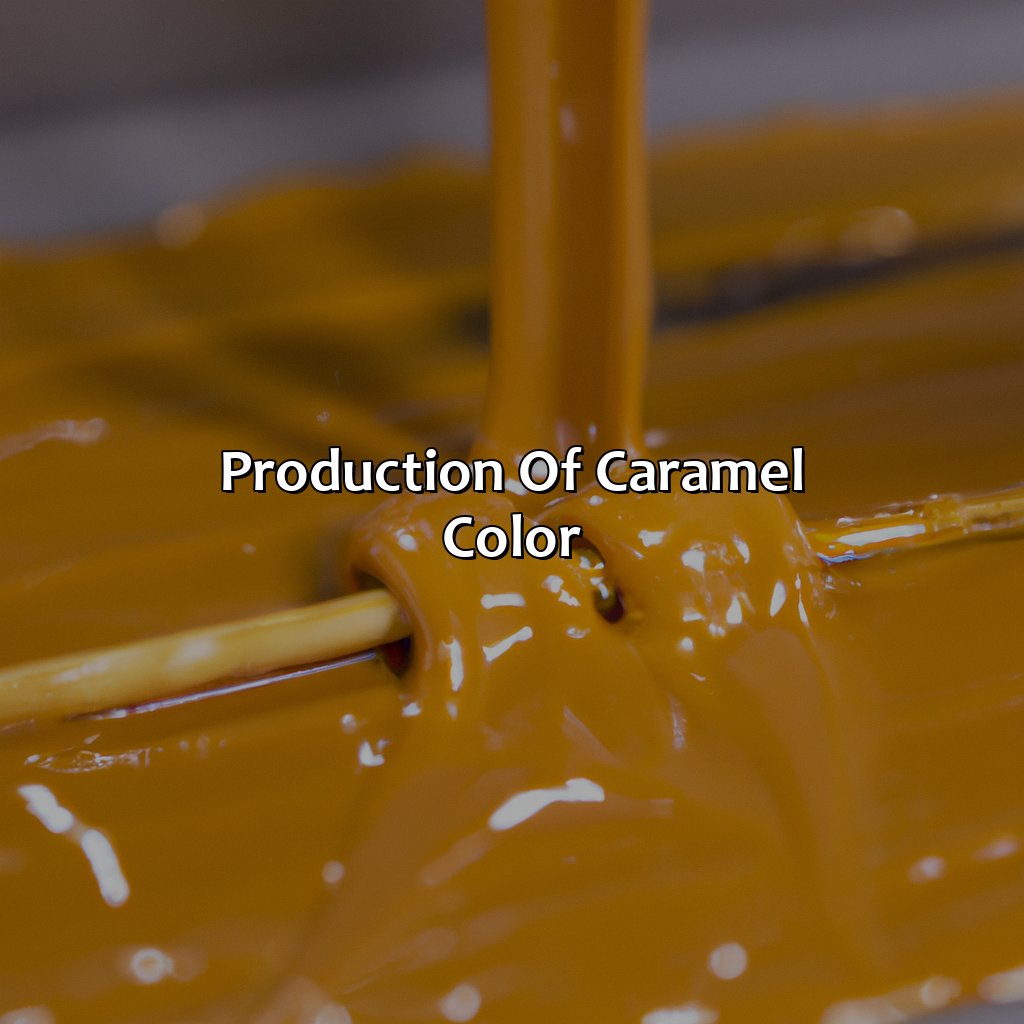
Photo Credits: colorscombo.com by Brian Rivera
You wanna learn about caramel colors? Let’s talk about the production process. Caramelization and heating techniques are important to achieving the right color. In this section, we’ll show you the methods used to make ’em. We’ll also discuss the raw materials used for flavoring and coloring, plus the regulations for production.
Methods of Production
Caramel color is produced through various techniques that differ depending on the desired properties. The production involves a heating process that causes the Maillard reaction to take place, thereby producing colorants of varying intensities and flavor profiles.
| Types of Production Methods | Description |
|---|---|
| Class I-IV | These methods involve the controlled heating of sugar or glucose syrup with or without added acids, alkalis, or salts. The degree of color and flavor depends upon the method used and the raw materials utilized. |
| Sulfite Process | A variation of Class III production method that involves adding sulfite compounds to enhance the overall quality of color and flavor. |
| Ammonia Process | A variation of Class III production method wherein ammonium compounds are added instead of sulfites, this produces a distinct burnt-sugar aroma in addition to caramel-like flavor and color. |
It is worth noting that controlling temperature and time during caramelization helps produce specific types of Caramel Color based on end-use industry requirements.
Pro Tip: The precise control of heating parameters, such as temperature and duration, can yield a wide range of desirable characteristics in Caramel Color for various industries’ specific needs.
Vegetable-based coloring and flavoring agents are the roots of caramel color production.
Raw Materials Used
Vegetables to Make The Color and Flavor of Caramel
Caramel color is produced from various raw materials. One major type of raw material is vegetables.
The table below lists some common vegetable-based coloring agents used in the production of caramel color and their sources.
| Raw Material | Source |
|---|---|
| Beet Sugar | Sugar beets |
| Molasses | Sugar cane |
| Corn Syrup | Cornstarch |
| Soy Sauce | Soybeans |
| Rice Syrup | Brown rice |
Notably, caramel color can be made from a range of other raw materials, including grains, starches, and sugars derived from corn and sugarcane. However, vegetable-based coloring agents are preferred due to their clean-tasting flavoring properties.
It’s interesting to note that some companies producing caramel color rely on specific suppliers for their raw materials. This ensures consistency in taste and appearance for their products while also maintaining optimal quality control measures.
Making caramel color is like walking a tightrope between FDA regulations and food labeling requirements for maximum food safety.
Regulations on Production
Caramel color regulations ensure the safety of its production for use in food and beverage industries. The FDA regulates the production process of caramel colors under CFR 21, Part 73.
| Regulatory Standard | Description |
| GRAS Listed | Caramel color is Generally Recognized as Safe by the FDA, meaning that it is acceptable for use in food products. |
| Labeling Requirements | The FDA requires all food products containing caramel color to be labeled accordingly with specific language describing the type and amount used. |
| FDA Regulations | The FDA enforces strict regulations on the production and usage of caramel color; ensuring it complies with food safety standards. |
It is important to note that compliance with these regulations guarantees the highest level of food safety while using caramel color. Food labeling also plays a crucial role in disclosing information concerning caramel color content, giving users peace of mind.
Studies have shown no link between consuming caramel coloring and cancer, but excessive consumption may increase hyperactivity in children.
In a study conducted by Food Additives & Contaminants Journal (2014), “Caramel colors contributed relatively little to exposure compared to other dietary sources,” indicating that daily doses of caramel coloring are safe within established guidelines according to BfR (Federal Institute for Risk Assessment).
Caramel color: making your food dark and mysterious, one soda at a time.
Uses of Caramel Color
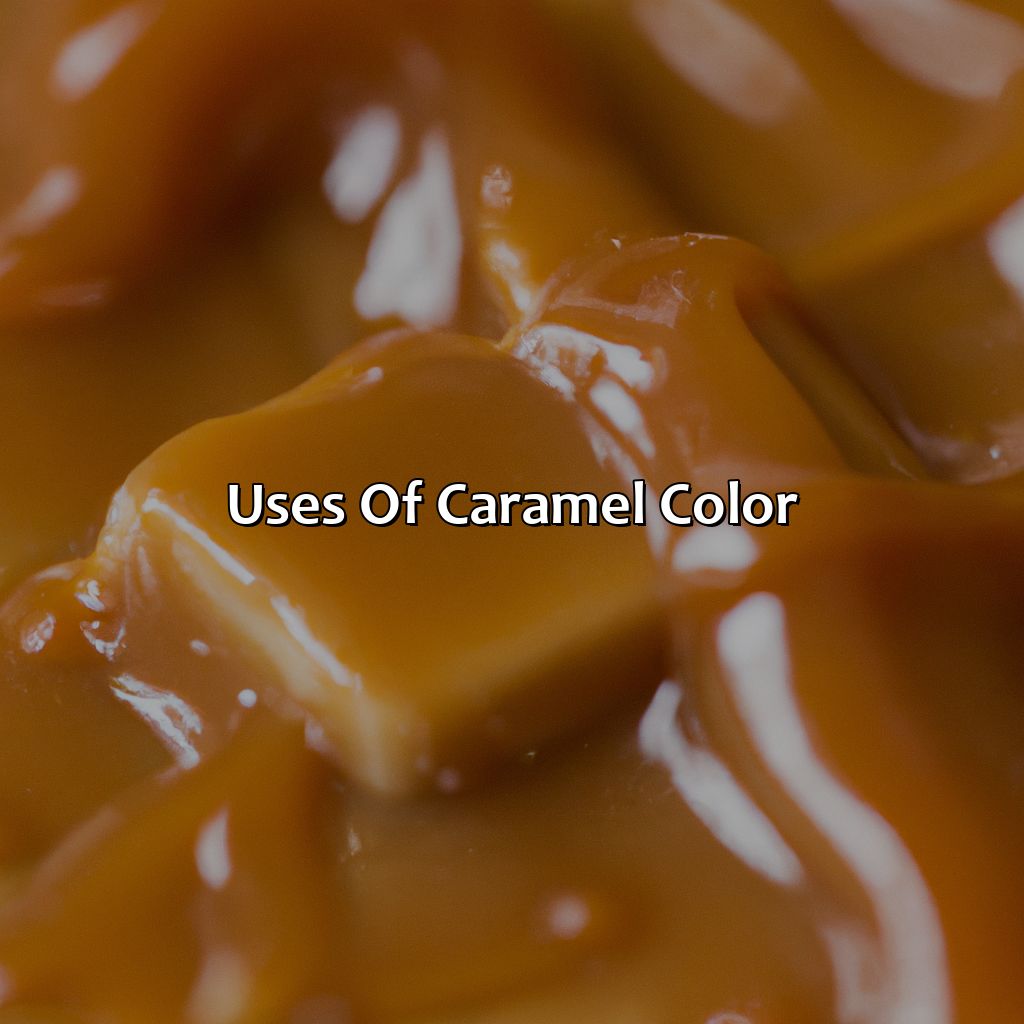
Photo Credits: colorscombo.com by Daniel Miller
We’ll investigate using caramel color in food and drinks. It has benefits for baked goods, beverages, and dairy. We’ll also look at its other uses, like animal feed, cosmetics, and textiles. Plus, we’ll cover important properties like color stability and shelf life.
Food and Beverage Industry
The use of Caramel Color is widespread in the food and drink industry. It is renowned for its versatility and ability to impart a range of colors that are visually appealing to consumers. As a result, it has become an essential ingredient for many manufacturers looking to achieve consistent colorings across their product range.
Baked goods, beverages and dairy products are some of the main categories where caramel color is commonly used. With baked goods, it can be found in bread, cakes and biscuits to create an attractive golden-brown exterior. In beverages like cola and stout beer, it is used to provide the classic deep brown hue. Additionally, dairy products like chocolate milk also benefit from caramel coloring as it adds richness to the overall appearance.
Furthermore, the widespread adoption of caramel color makes it a crucial part of the food industry. According to Food Chemistry Journal (2017), The global caramel coloring market was valued at over $2 billion in 2016, with robust growth expected over the next few years.
It’s clear that Caramel Color plays a significant role in enhancing the overall aesthetics of food and drink products while also being incredibly versatile in its application.
Caramel color: because even animal feed wants to look good.
Other Industries
Caramel color is not only limited to the food and beverage industry but it is also used in other industries. Animal feed industry uses caramel color as a flavoring agent while the cosmetic industry utilizes it for hair dyes and beauty products. Textile industry also uses caramel color as a dye or stain.
In the animal feed industry, caramel color is often utilized as a coloring agent in pet food to make it look more appealing to consumers. It acts as a flavor enhancer too. In the cosmetic industry, caramel color is commonly found in hair dyes and self-tanners which gives an attractive brown hue without the use of harsh chemicals. The textile industry also uses caramel colors as a dye or stain on textiles.
Moreover, Caramel colors have some unique properties that make them ideal for these other industries too. They are stable under different temperature and pressure conditions, non-toxic, soluble in water and offer excellent coloring properties.
If you’re looking for alternatives, there are natural options such as beet juice or turmeric. However, if synthetic alternatives are what you’re interested in, synthetic dyes such as Red 40, Yellow 5, and Blue 1 can be substituted for artificial coloring purposes.
Missing out on incorporating caramel color into your product line can result in losing customers’ interest who prefer darker tones for their purchases. Explore different usages of caramel color to benefit other industries without compromising health standards established by FDA regulations or consumer demands. Why settle for a relationship with unstable color when Caramel Color provides color stability and a longer shelf life?
Important Properties
Caramel Color and its Crucial Attributes
Caramel color brings a rich brown hue, an appetizing aroma, and a unique flavor to various food products. It is the most widely used natural coloring agent in the food and beverage industry because of its many essential properties that make it an excellent choice for food manufacturers.
Table: Important Properties of Caramel Color
| Properties | Description |
|---|---|
| Color stability | It provides uniform coloration with exceptional stability over different pHs |
| Flavor enhancement | Adds flavor and aroma to food products without altering the taste |
| Shelf life extension | Improves the shelf life of food by preventing oxidation and rancidity |
| Heat resistance | Can withstand high heat in various food processing techniques |
Along with these characteristics, caramel color also improves emulsification, masks off-flavors, prevents enzyme degradation, and enhances sensory attributes such as texture. This versatile ingredient adds aesthetic value to beverages like alcohol, colas, iced tea, sports drinks as well as confectionaries, bakery items like bread, cakes, and biscuits.
Though caramel colors are approved by FDA regulations and safe for consumption within prescribed limits; they might pose minimal health risks if consumed excessively or ingested in low doses on a continuous basis. Some studies suggest that 4-methylimidazole (4-MEI), which forms during an unintended reaction during production when treated with certain raw materials such as ammonia may increase the risk of cancer upon prolonged exposure beyond FDA guidelines.
Manufacturers continue to explore alternatives for caramel color that mitigate any potential harm. Natural options derived from plant-based sources such as beetroot or annatto extracts contain healthy antioxidants whereas synthetic substitutes provide consistency without compromising taste.
Don’t miss out on ensuring healthy practices to prolong your well-being! Adding caramel color to your food isn’t worth the potential toxicity and carcinogenic properties.
Safety and Health Concerns

Photo Credits: colorscombo.com by Michael Thomas
It is critical to grasp the toxicity and carcinogenicity of caramel color to guarantee food additive safety. To keep using caramel color, one must be aware of FDA approval safety standards and the related risks. This section looks into FDA Approval and Safety Standards, concentrating on colorfastness. Moreover, it discusses the Health Risks Associated with Caramel Color, for example, product differentiation and production cost.
FDA Approval and Safety Standards
Caramel Color and Safety Standards
This colorant is recognized as safe by the FDA and widely used in food and beverage industries. The regulatory standards for caramel color are strict, ensuring that it meets quality requirements, purity, and safety criteria.
Manufacturers must comply with Good Manufacturing Practices (GMP) and follow specific guidelines before introducing caramel color into their products. The FDA has set the maximum use levels of caramel color in various food categories. This ensures consumers’ safety by limiting the amounts of caramel color being consumed.
Notably, there are concerns that its consumption could lead to cancer due to a compound called 4-methylimidazole(4-MEI), which is formed during its production process. Hence, the concentration of 4-MEI in this additive is adequately regulated by government agencies.
Recently, a large-scale study by the National Toxicology Program concluded that there was no clear evidence linking 4-MEI with cancer risk. Nonetheless, people should hedge against unnecessary risks concerning this food additive.
One company using caramel colors boasted about how their new technology improves dyeing efficiency while mitigating harmful chemicals’ environmental impact on workers and the environment. Their innovative method also resulted in improved colorfastness that required less energy to lock dye onto fabrics compared to traditional processes, leading them towards business success while contributing positively to society’s welfare.
Looks like caramel color is not just causing a dent in our wallets, but also in our health.
Health Risks Associated with Caramel Color
Caramel Color and Health Concerns
Consumption of caramel color is a potential threat to human health. Caramel color has been linked to harmful carcinogenic properties that can increase the risk of cancer. Such harmful properties arise due to prolonged use, high concentration, or inappropriate production procedures. Its excessive consumption may lead to severe health issues such as obesity, cancers, liver damage, and diabetes.
Furthermore, manufacturers add caramel color to meet the ever-increasing demand for inexpensive ingredients and product differentiation. At times, this practice overlooks health risks associated with continuously consuming manufactured foods laced with caramel color. While it remains legal for certain food products’ use, consumers must be aware of its potential harm.
Nonetheless, switching from synthetic colors may increase production costs. Industries vying for environmental benefits might opt for natural alternatives like Annatto extracts or beet juice instead of synthesized options like caramels. Producers cultivating these alternate methods pose more challenges since they are perishable.
Historically speaking, there have been numerous changes in legislation governing the use of coloring agents in comestibles. However, through rigorous research and monitoring by administrative agencies such as the FDA, harmful alternates have replaced former chemicals known to be toxic over time.
You can either go natural or fake it till you make it – the two alternatives to caramel color.
Alternatives to Caramel Color
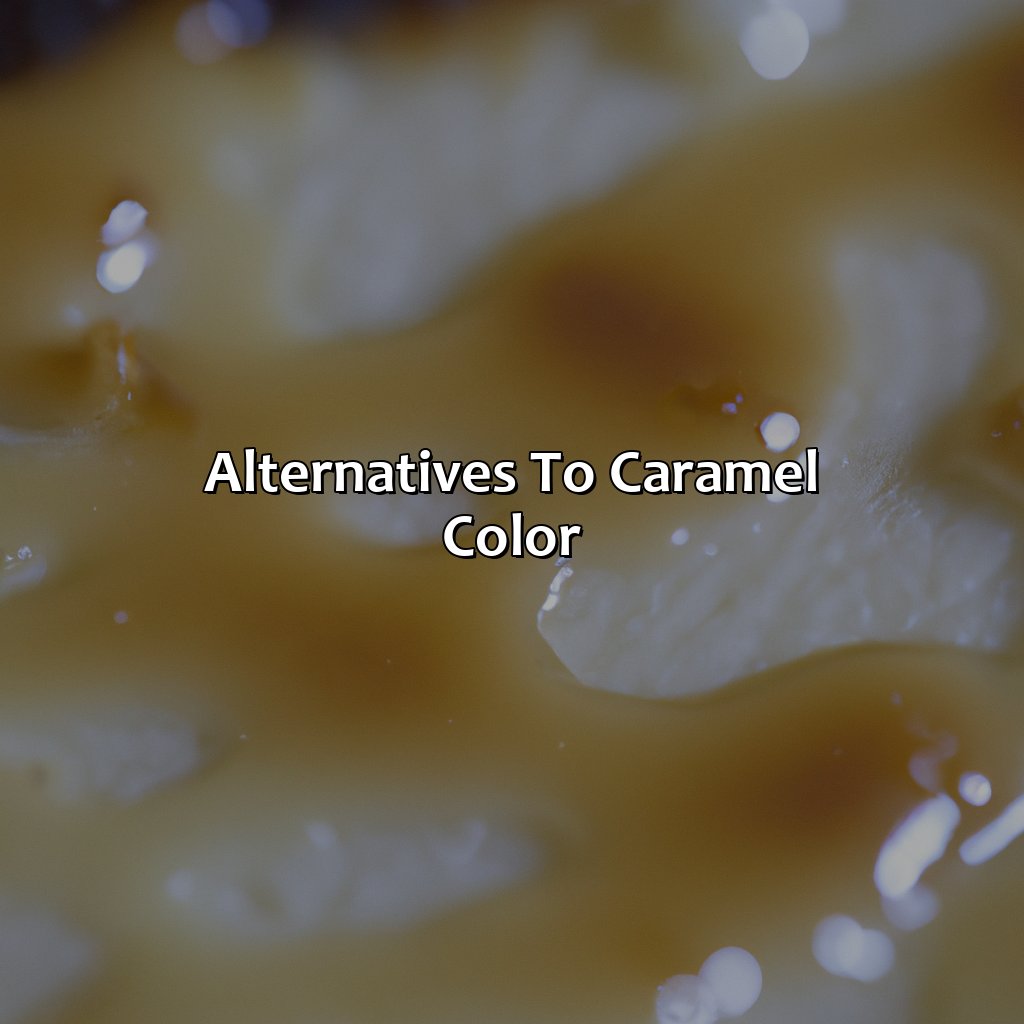
Photo Credits: colorscombo.com by Daniel Miller
Want to find alternatives to caramel color? Let’s explore! We have two different sections: natural and synthetic.
- Natural alternatives include organic caramel color, clean label, and eco-friendly solutions.
- Synthetic alternatives are artificial sweeteners and low-calorie foods.
Natural Alternatives
Organic Alternatives for Caramel Color
Caramel color has been a popular food coloring for many years, but due to the increasing demand for clean label and eco-friendly products, natural alternatives are gaining traction. Here are some organic caramel color alternatives:
- Beet Sugar: Beet sugar creates a warm brown color and is an excellent substitute for caramel color. It is a natural sweetener and does not change the flavor profile of the food product.
- Turmeric: A bright yellow-colored spice that can be used in small quantities to achieve light shades of caramel. Turmeric is known for its anti-inflammatory properties and adds a mild earthy flavor to food products.
- Brown Rice Syrup: This syrup provides a rich taste that is comparable to caramel. It can be used to enhance flavors and create an appealing color.
Organic caramel coloring provides an unadulterated option to enhance the appearance of food products while maintaining their nutritional value. The use of these natural alternatives aligns with consumer’s preference towards healthy lifestyle choices.
Pro Tip: When using these organic substitutes, it’s important to note that some may alter the taste or texture of the final product; hence, experimentation with different quantities may be required.
Synthetic alternatives may offer low-calorie options, but just like an artificial sweetener, they never quite satisfy like the real thing.
Synthetic Alternatives
Caramel color is a popular food coloring agent, but there are synthetic alternatives available as well. There are several synthetic substitutes for caramel color that food and beverage manufacturers use to make their products look more appealing. These alternatives create the same effect as caramel color on a product’s appearance.
One alternative to caramel color that is often used in the food and beverage industry is artificial sweeteners. These sweeteners offer low-calorie options that give products an attractive brown hue without adding extra calories.
Another option is to use natural food colors like vegetable juice concentrate or turmeric. However, these may not provide the same depth of color as caramel color or its synthetic alternatives.
It’s worth noting that not all synthetic alternatives to caramel color are considered safe; some may pose potential health hazards. Food and beverage manufacturers should opt for FDA-approved options only.
To ensure safety, manufacturers must evaluate the impact of additives carefully. Depending on the case at hand, regulatory compliance with requirements such as labeling and packaging could help consumers choose safer products over dubious ones with questionable ingredients.
Five Facts About Caramel Color:
- ✅ Caramel color is a dark brown, liquid food coloring derived from heating sugar. (Source: The Spruce Eats)
- ✅ It is commonly used in food and beverage products to enhance their appearance and add flavor. (Source: Healthline)
- ✅ Caramel color is found in a variety of products such as soft drinks, beer, sauces, and baked goods. (Source: Food Insight)
- ✅ The primary types of caramel color are Class I, II, III, and IV, with each type varying in its method of production and color intensity. (Source: Food Additives & Contaminants)
- ✅ The safety of caramel color has been extensively studied and it is generally recognized as safe (GRAS) by regulatory agencies such as the FDA. (Source: FDA)
FAQs about What Is Caramel Color
What is caramel color?
Caramel color is a highly concentrated liquid or powdered food coloring used in food and beverage applications. It is created by heating carbohydrates, such as sugar, until they break down and form a dark colored syrup. Caramel color adds a rich brown color and slightly sweet taste to food and beverages.
Is caramel color safe to consume?
Yes, caramel color is safe to consume in moderate amounts. It is approved by regulatory agencies around the world, including the FDA in the United States. However, excessive consumption of caramel color can lead to health concerns.
What foods and beverages is caramel color commonly used in?
Caramel color is commonly used in soft drinks, beer, soy sauce, baked goods, and many other food and beverage applications. It is often used as a coloring agent for its deep brown color and as a flavor enhancer for its slightly sweet taste.
Does caramel color contain any allergens?
Caramel color does not contain any known allergens, making it a safe ingredient for those with food allergies. However, it is always important to check the ingredient list of a product to ensure that it does not contain any other allergens.
What is the difference between caramel color and caramel flavoring?
Caramel color is a coloring agent used to add a brown color to food and beverages, while caramel flavoring is a concentrated liquid or powder that is used to add a caramel taste to food and beverages. Caramel flavoring is often used in baked goods, candies, and desserts.
Can caramel color be used in vegan and vegetarian products?
Yes, caramel color can be used in vegan and vegetarian products. It is typically made from plant-based ingredients such as sugar, corn, and barley. However, it is always important to double-check the ingredient list of a product to ensure that it aligns with your dietary requirements.




